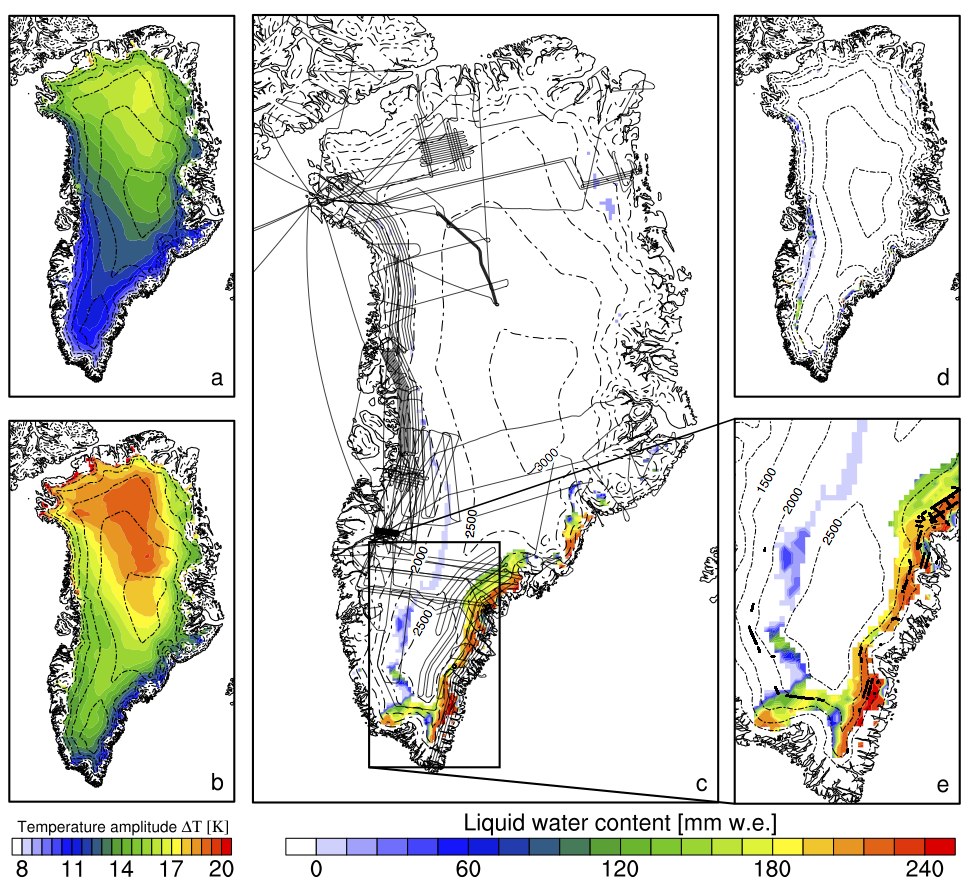Peter Kuipers Munneke
Assistant professor in Glaciology
About me

I am an assistant professor in the field of glaciology and polar meteorology at the Institute for Marine and Atmospheric research Utrecht (IMAU), part of Utrecht University, The Netherlands. I'm active on Mastodon.
Featured paper: Firn review paper
We study firn because it contains clues about past climate, because it modifies meltwater runoff into the ocean, and because it can help us to measure ice-sheet mass change from space using satellites. After a lot of hard work, an overview paper on firn is out!
Blue ice in Antarctica
Using a spectral unmixing technique, we map daily fractions of blue-ice area over Antarctica for the 22-year period since 2000, using the full available MODIS archive. This FABIAN product is published in Remote Sensing of Environment.
Liquid water in the Greenland firn
In April 2011, glaciologists from NASA were puzzled when they saw their airborne radar record a strong reflecting layer at 10 to 50 metres below the surface of the Greenland Ice Sheet. It couldn't possibly be liquid water. After all, it was still winter, and the surface temperature was hovering around -20 or -30 degrees Celsius.
Or could it be water after all?
They returned a year later, this time with drilling equipment. To their excitement, they recovered water-soaked firn from 10 to 30 metres below the surface (see movie clip).
Using a model for the firn layer, I and my colleagues found out that the water can survive the harsh Greenland winters because it is isolated from the cold by a thick blanket of fall and winter snow.
A firn model
To explain how liquid water can survive the extreme Greenland winters, we went back to the basics, and wrote a computer program that simulates what happens in real firn. We can tell the model how much snow is falling at what temperature, when snow at the top is melting, and how the meltwater seeps into the firn. We let the computer calculate what happens with the meltwater for different amounts of annual snowfall, and for different temperatures.
Isolating snow
It turns out that, first of all, you need sufficiently high summer temperatures to create a firn aquifer. Otherwise, there is just not enough meltwater. Moreover, it turns out that you need quite a bit of annual snowfall (more than 3 metres of snow annually) for a firn aquifer to form. The role of the snow is to cover the melting summer snow with a sufficiently thick layer in fall and winter to isolate it from the winter cold. Snow is fluffy and porous, and therefore it is a perfect insulator (many animals know that snow has this property: they dig caves to hibernate through the winter). The snow thus isolates the wet summer firn from the winter cold.
Testing the model
To see whether the model predicts a firn aquifer correctly, we took snowfall and temperature maps from Greenland and used that to let the firn model calculate whether there would be a firn aquifer or not. It turns out that the model predicts a firn aquifer at the same locations where airborne radars have detected one. It means that the model is useful for predicting the existence of a firn aquifer.

In panel (c), you see where the model predicts the existence of firn aquifers. It is mainly in the southeast, where there is a lot of melt in summer, and a lot of snowfall in winter due to its location with respect to the climatic Icelandic low pressure area. In panel (e), you see the black lines and dots where the firn aquifers has also been observed with airplanes.
The Southeast
Lots of snow and lots of melt. You'll find this combination of ingredients for firn aquifers mainly in the southeastern part of Greenland. Temperatures decrease with latitude, so most melt is in the south. The southeastern coast is by far the wettest place in Greenland: winds circling anti-clockwise around the climatological Icelandic low pressure system dump metres of snow in the southeast, as they collide with the very steep mountains rising up from the ocean immediately on the Greenland east coast.
Sea-level rise
The initial discovery of the firn aquifer raised many new questions, and many of those still remain unanswered. Has the aquifer been around for a long time or is it a recent phenomenon? Is the firn aquifer able to retard the delivery of meltwater to the ocean, and thereby modulate the rate of sea-level rise? Furthermore, it has been suggested that firn aquifers keep meltwater away from the subglacial drainage system, which strongly influences how fast the glacier ice slides into the ocean. It thus seems important for future studies to treat the ice flow in aquifer regions different from the ice flow elsewhere.
Read more
This research was published in January 2014 in Geophysical Research Letters: Kuipers Munneke, P., S. R. M. Ligtenberg, M. R. van den Broeke, J. H. van Angelen and R. R. Forster (2013). Explaining the presence of perennial liquid water bodies in the firn of the Greenland Ice Sheet. Geophys. Res. Lett., 41(2), 476-483, doi:10.1002/2013GL058389. This research was funded by NWO/ALW, and carried out by researchers from IMAU (Utrecht University) and The University of Utah (Salt Lake City, USA).